 |
 |
 |
 |
 |
 |
 |
 |
 |
 |
 |
 |
 |
 |
 |
 |
 |
 |
 |
 |
 |
 |
 |
 |
 |
 |
 |
 |
 |
 |
 |
 |
 |
 |
 |
 |
 |
 |
 |
 |
 |
 |
 |
 |
 |
 |
 |
 |
 |
 |
 |
 |
 |
 |
 |
 |
 |
 |
 |
 |
 |
 |
 |
 |
 |
 |
 |
 |
 |
 |
 |
 |
 |
 |
 |
 |
 |
 |
 |
 |
 |
 |
 |
 |
 |
 |
 |
 |
 |
 |
 |
 |
 |
 |
 |
 |
 |
 |
 |
 |
 |
 |
 |
 |
 |
 |
 |
 |
 |
 |
 |
|
|
Jack May's War |
|
|
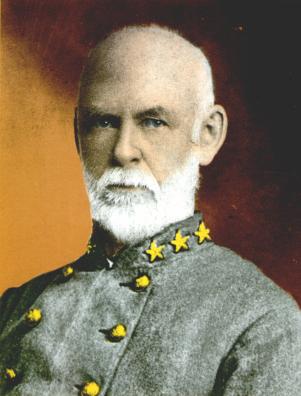 |
|
|
|
|
|
 |
|
|
|
|
|
|
Chapter One:
The Cause of Civil Freedom |
|
|
|
|
|
|
|
|
|
 |
|
|
|
During the first months of the Civil War, Kentucky Governor Beriah Magoffin and other Kentucky leaders fought hard to keep the state neutral. Their hopes were dashed by the August 1861 election, which sent a Unionist majority to Frankfort. When the new legislature convened in early September, it passed laws which encouraged Federal occupation and suppressed the rebellion. Home guards were organized in every county, Federal Marshalls began arresting men suspected of treason, and Federal Soldiers took possession of Paducah, Louisville, and other strategic points. |
|
|
|
This sea-change in the state's political fortunes had a dramatic effect on Kentuckians who favored the Southern cause. Take Hiram Hawkins, for example. A Bath County farmer, Hawkins was a pro-secessionist member of the legislature and a colonel in the state militia. One afternoon in early September, 1861, a messenger arrived at his home in Owingsville and warned him that Federal troops were coming to arrest him and throw him in jail. Hawkins immediately called together seventeen of his most trusted militiamen, and, at twelve o'clock that evening, armed and equipped for battle, they set out for West Liberty, a town thirty-five miles east of Owingsville, where a young lawyer named Jack May was organizing a pro-secessionist company of Morgan County Guards. |
|
|
|
When Hawkins reached May's camp, the two men analyzed the situation and decided that it would be prudent to move their little army to a more secure location. Prestonsburg was the logical choice. There, deep in the mountains of Eastern Kentucky, surrounded by people of Virginia ancestry, recruits could be collected, organized, and trained for battle. Moreover, Jack's cousin William James May owned a farm north of town--Jack's boyhood home--with a meadow big enough and level enough for a military camp. |
|
 |
|
|
|
|
One of the problems facing the two men was the question of how their recruits would be fed. The best thing about the May Farm was that it was located next to the steam-powered grist mill which Jack's father had erected at the mouth of Abbott Creek in 1849. Indeed, this feature of the farm eventually became so important that throughout the duration of the war, commanders on both sides referred to the farm as "the steam mill" in their battle reports. |
|
|
|
|
|
|
1882 Map of Floyd County showing location of May House. Click here. |
|
|
|
|
|
 |
|
|
|
|
The May House
in 1936. Click here. |
|
|
|
|
|
|
Hawkins' men were the first soldiers to pitch their tents at the farm. On the following day, May's company arrived, and several days later, a company led by Owingsville store-keeper G.W. Connor showed up. Meanwhile, at the Floyd County Courthouse, meetings were held, committees were formed, and resolutions were passed urging all able-bodied men to arm themselves and prepare for war. W.H. Burns of West Liberty, Judge of the Circuit Court, was elected Commissary in charge of supplies, and Captain Hawkins was elected Camp Commander. Throughout the last half of September, recruits continued to arrive, including two companies from Harrison County commanded by John Shawhan and Benjamin Desha, and two companies from Bourbon County commanded by E.F. Clay and James M. Thomas. |
|
|
|
During this hectic period, the road through Prestonsburg was thronged with Confederate volunteers and other individuals seeking refuge behind Confederate lines. Lewis Collins' Annals of Kentucky shows that during the last four days of September, 1861, "nearly one thousand armed Kentuckians" passed through Prestonsburg on their way to Southwestern Virginia. "All finely mounted and well-armed," they included Colonel William Preston of Lexington, Congressman William E. Simms of Paris, Colonel George B. Hodge of Newport, and Senator John C. Breckinridge of Lexington, the nation's foremost advocate of the Southern Cause. |
|
|
|
 |
|
|
|
The Southern Democratic Party's nominee for President in 1860, Breckinridge had many enemies, and it was rumored in some quarters that he had been murdered. On October 7th, however, the Wheeling Press reported that he had eluded his captors and arrived safely at Jeffersonville in Tazewell County, Virginia, after a two-hundred-mile journey by carriage through Eastern Kentucky. Along the way he had stopped at Owingsville, West Liberty, and Prestonsburg, where he had inspected the camp of the 5th Kentucky Infantry at the May Farm: |
|
|
|
At this latter place [Prestonsburg] he made a speech and rallied some three hundred recruits. Thence to Piketon, in Pike County, where he staid three days, and thence across the Cumberland Mountains at Dogwood Gap into Virginia, through Buchanan, Russell and Tazewell counties to Tazewell Court House, where he remains. |
|
|
|
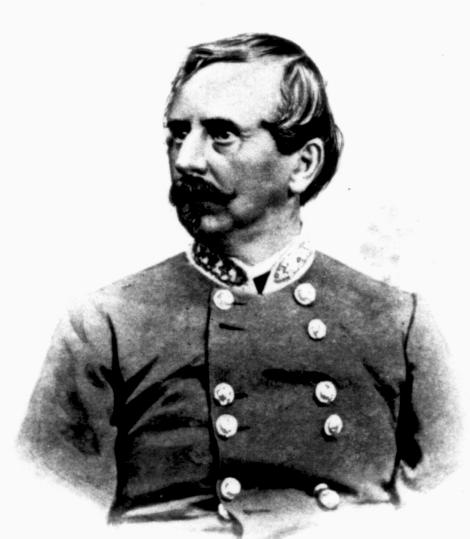 |
|
|
One of the great diarists of the Civil War was Mary Chesnut, wife of Jefferson Davis' aid-de-camp, Colonel James Chesnut. On October 3rd, 1861, she recorded: "Breckinridge, William Preston, and Clay have escaped Seward's little bell and are safe now in the part of Kentucky which is loyal to the South." |
|
|
|
|
|
Brigadier General William Preston of Lexington. For a larger image, click here. |
|
|
|
|
|
|
|
|
Meanwhile, back at the May Farm, tents were springing up like mushrooms after a summer rain. On October 2nd, Jack May and his comrades-in arms sent the following letter to Jefferson Davis in Richmond: |
|
|
|
To His Excellency Jefferson Davis,
President of the Confederate States of America: |
|
|
|
Sir: Our legislature has betrayed us. We have marched to this point on account of its strategic importance with 1,000 men. Hundreds are gathering around our standard daily. We can have 5,000 men here in two weeks. We would most respectfully petition Your Excellency to send us immediately some experienced military man to command us, and place us upon a footing to make ourselves available in furthering the cause of civil freedom, in which we have enlisted, and to which we pledge our lives and our sacred honor. |
|
|
|
Ben Desha,
Captain of Light Infantry Company (armed).
E.F. Clay,
Captain of Cavalry Company (armed).
James M. Thomas,
Captain Mounted Rifles (forty minies, with equipment).
T.R. Worsham,
Infantry (unarmed).
H.C. Swango,
Infantry (unarmed).
A.J. May,
Captain Morgan Guards, Infantry (unarmed).
Jesse Meek,
Infantry (unarmed).
G.W. Connor,
Captain, Infantry (unarmed).
G.M. Ewing,
Captain, Infantry (unarmed).
John W. Sparks,
Captain, Infantry (unarmed).
John Shawhan. |
|
|
|
These men were not low-class riffraff. John Shawhan was a former state representative from Harrison County and a veteran of the Mexican War. Benjamin Desha, also from Harrison County, was the grandson of Joseph Desha, Governor of Kentucky from 1824 to 1828. James M. Thomas and Ezekiel Clay came from Bourbon County, and the latter was the son of Brutus J. Clay, a wealthy Bourbon County cattle-breeder. G.W. Connor's father owned a store in Owingsville, and G.W. Ewing's father was the proprietor of an Owingsville foundry. Henry Chapman Swango was a school teacher in Hazel Green and the son of a prosperous Wolfe County farmer. |
|
|
|
The developments in Prestonsburg alarmed the Union men in Louisville. On October 13th, the Pro-Union Louisville Evening News reported that a group of "secessionist notables" were organizing "a large rebel camp" at that location. "They have a force of 6,000 or 7,000, whom they are drilling eight hours per day, and they are alarming the mountaineers by circulating incredible stories as to the intentions of the Government." |
|
|
|
 |
|
|
|
|
Brigadier Generala William T. Sherman, Union Commander at Louisville during the Fall of 1861. |
|
|
|
|
|
|
|
|
Like other secessionists, Jack May and his comrades-in-arms saw themselves as defenders of "the cause of civil freedom." What did they mean by this phrase? It is true that certain freedoms had been jeopardized by Lincoln's election, including the freedom to buy and sell slaves. It would be a mistake, however, to assume that the slavery issue was uppermost in these men's minds. The Eastern Kentucky economy wasn't dependent on slavery, and only the wealthiest farmers owned them. Samuel May never owned more that two or three at any one time, and the U.S. Census shows that in 1860, Jack May owned three slaves. |
|
|
|
The issue which did concern these men was the issue of Federal coercion. They held fast to the doctrine that states had the right to withdraw peacefully from the Federal Union. In the political climate of 1861, as the case of Hiram Hawkins illustrates, Kentuckians who publically advocated this doctrine risked being arrested and jailed. |
|
|
|
Ultimately, however, it was a question of loyalty more than principle. As my history of the May House shows, the first families to settle Eastern Kentucky had migrated from Southwestern Virginia and Eastern Tennessee, and their descendants felt bound to the South by ties of family, custom, and tradition. George Washington Noble of Breathitt County, a private in Captain Henry C. Swango's company, put the matter this way: |
|
|
|
I was in the Confederate army because it was just as good as the Northern army, and my grandfather came from the South, and I liked the Southern people the best. |
|
|
|
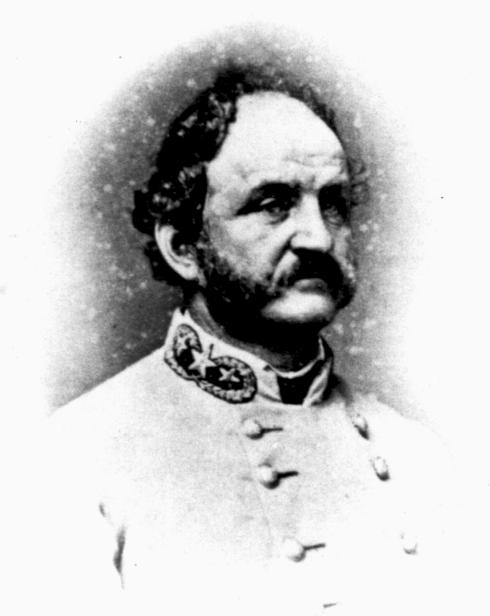 |
|
|
|
Sometime in mid-October, learning that a Union army was being organized at Maysville, Jack May moved his Morgan guards back to West Liberty. At that location, on October 21st, 1861, it was mustered into the service as Company A of the 5th Kentucky Infantry, C.S.A. The terms of their enlistment obligated them to serve twelve months. About this same time, Colonel John S. Williams, a Montgomery County farmer, railroad-builder, and Mexican War hero, arrived in Prestonsburg and took command of the rest of the regiment. |
|
|
|
|
|
Colonel John S. Williams, first commander of the Fifth Kentucky Infantry, C. S. A. Click here. |
|
|
|
|
|
According to the pro-Confederate Louisville Courier, the 5th was composed of "hardy, raw-boned, brave mountaineers" who were "burning with desire to drive out the Abolition hordes of King Lincoln, who have dared to invade the sacred soil of Kentucky." |
|
 |
|
On September 15th, 1861, General Sherman, the Union commander at Louisville, ordered William "Bull" Nelson to go to Maysville, organize an army, and drive the 5th Kentucky out of the Big Sandy Valley. |
|
|
|
|
|
Brigadier General William Nelson |
|
|
|
|
|
|
|
|
|
|
 |
|
|
The army which Nelson put together consisted of four Ohio regiments and an assortment of Kentucky volunteers and militiamen. On October 23rd, they marched from Maysville to West Liberty, where they engaged Captain May's company in a brief skirmish. With Nelson's columns in pursuuit, May then marched his men up the Pound Gap Road to Prestonsburg, bivouacked them at the May Farm, and began looking for a place to make a stand. By this time, Colonel Williams had moved the main body of the 5th to Piketon. |
|
|
|
|
|
|
Part of General Buell's 1863 Map
of Eastern Kentucky. Click here. |
|
|
|
Recalling how the narrow defile at Thermopylae had helped a small Greek army defeat a much larger army of Persians, Jack decided to make his stand at Ivy Narrows, a place on the wagon road between Prestonsburg and Piketon where it was hemmed in on the left by the steep slopes of Ivy Mountain, and on the right by the steep banks of the Big Sandy River. Half of his men he concealed behind breastworks on a level benchland overlooking the pass, and the other half he concealed in a cornfield on the opposite side of the river, hoping to catch the Federals in a deadly cross-fire. While his men fortified their position, they were joined by companies led by Captain Hawkins and Captain Thomas, making a total of approximately two hundred and fifty men. Then, mounting his horse, May galloped up the road and began scouting for the enemy. To his three companies he shouted, "Don't fire until you hear my pistol crack." |
|
|
|
On November 5th, the New York Times reported that Nelson had reached Prestonsburg and captured it without a fight. |
|
|
|
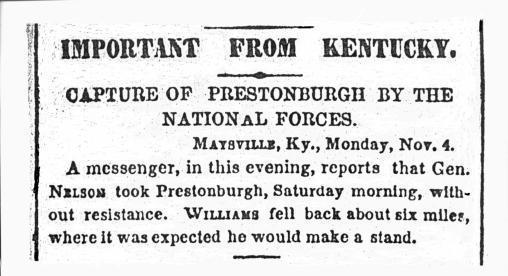 |
|
|
|
|
New York Times, November 5th, 1861. For a larger image, click here. |
|
|
|
|
|
|
Realizing that the rebels had retreated to Piketon, Nelson devised a two-pronged attack on that town, sending two regiments up Johns Creek and three regiments up the east side of the Big Sandy on the Pound Gap Road. Three days later, his scouts discovered May's position at Ivy Mountain. Recognizing that the rebel position was a strong one,Nelson wheeled two of his six cannon to the river's edge and began shelling the rebels. Then he ordered Harris' regiment to climb the mountain and deploy along its side, and sent Marshall's regiment up the road in a frontal attack. When the Federals came within range of the rebel guns, Jack's pistol cracked, the rebel line erupted in fire, and the battle began. |
|
|
|
The first volley was a bloody one, killing four Federals and wounding thirteen. Nelson later reported that "the mountainside was blue with puffs of smoke, and not an enemy to be seen." The report of the rebel commander, Colonel John S. Williams, reads as follows: |
|
|
|
At 1:30 o'clock on the 9th instant, the enemy moved up to Captain May's position [Ivy Creek] with a force of 1,600 men and a battery of six pieces, and were received by 250 rifles and shot-guns, in point-blank range, every one of which took effect. Their columns wavered and fell back, but returned in good order, and attempted to carry the pass by assault under cover of their cannon, but were repulsed again with terrific slaughter. They then withdrew beyond the range of our shot-guns, and their infantry up the hills soon outflanked our little band, compelling them to fall back behind the burned bridge. Here our force made a stand, but the enemy advanced no farther. |
|
|
|
According to Nelson, the battle lasted for an hour and twenty minutes. The rebels weren't dislodged from their position until a third Federal regiment under Colonel Norton climbed the northern side of the mountain and descended upon the rebels from their rear. When Norton's men pressed their attack, May's company and the other rebel units gave ground and beat a hasty retreat across the Ivy Creek Bridge. In the confusion, some were pushed off the bridge and into the shallow water. By and large, however, according to Floyd County historian Henry Scalf, the retreat was an orderly one. In his account of the battle in Kentucky's Last Frontier, he says that "the retrograde movement did right itself enough to prevent utter disaster." After the Confederates had gone several miles up the road towards Piketon, they blocked their retreat by felling trees and destroying bridges. |
|
|
|
Scalf's claim that the retreat was an orderly one is supported by the fact that only six of the fleeing rebels were captured. Two of them, William Osborne and James Hereford, both of Prestonsburg, were captured together, and the story of their capture has been preserved by their descendants. According to the tradition, when the two men realized that they were surrounded and cut off from their unit, Osborne raised his rifle and took a bead on a Union officer, but Hereford, the wiser man, knocked the weapon aside. They were subsequently taken to Piketon and lodged in the county jail along with the other rebel prisoners. Since Hereford's grandfather was Pike County Sheriff William Ratliff, members of that family soon obtained his release. By the way, James's father, a Prestonsburg physician and a loyal Union man, later served as surgeon for Colonel John Dils's 39th Kentucky Volunteer Infantry. |
|
|
|
Reports of the battle published in Northern newspapers were wildly inaccurate. On November 13th, for example, the New York Times reported that the Federals had "gained a glorious victory," and that four hundred rebels had been killed and four thousand taken prisoner. Nelson, however, in his official report, didn't mention any prisoners and noted only that thirty-two enemy dead had been found on the field. On November 19th, the Cincinnati Gazette published a report based on an interview with Brigade Surgeon Bradford, who claimed that eleven enemy dead had been buried by Federal troops. This is probably an accurate figure. Colonel Williams, in the report he sent to Richmond, listed his losses as ten dead, fifteen wounded, and forty missing. |
|
|
|
According to Marshall Davidson of Prestonsburg, the battle was fought on and around the farm of Samuel Davidson (1800-1854), Jack May's father-in-law. It enclosed land now occupied by the modern community of Ivel. Old-timers say that the battleground was located several hundred yards west of the present Ivel Post Office and immediately west of the Wagon Wheel Restaurant. When Highway 23, the main route between Prestonsburg and Pikeville, was widened in 1971, most of this site, which had formerly been marked by a cemetery and a flagpole, was destroyed. |
|
|
|
During the antebellum period, the Davidson Farm rivaled the May Farm in size and importance. The farmhouse was located immediately east of the oldest section of Davidson Memorial Gardens, one of the oldest cemeteries in Floyd County, where Samuel and his wife Judith are buried. We can form some estimate of Samuel's wealth from the fact that in 1860, according to the U.S. Census, Judith owned seventeen slaves. Henry Scalf claims that during the Ivy Mountain fight, General Nelson positioned his cannon "almost at the foot of cemetery hill"--the previously-mentioned old section of Davidson Memorial Gardens. Marshall Davidson preserves the tradition that during the battle, Samuel Davidson's children crossed the Big Sandy in a rowboat in order to avoid being hit by rifle fire. |
|
|
|
Although the Battle of Ivy Mountain was a Confederate defeat, it did delay Nelson's progress long enough to allow Williams to withdraw his troops from Piketon and establish a winter camp at Pound Gap. After occupying the town for a week or so, Nelson decided not to pursue the rebels any farther, reasoning that their lack of supplies and the lateness of the season would make a counter-attack unlikely. He then withdrew his troops from the region. |
|
|
|
According to an article published in the Cincinnati Gazette on November 19th, one of his regiments was loaded aboard rafts and sent down the river to Catlettsburg, and the other four were marched back to Maysville and loaded aboard steamboats bound for Louisville. One of the rafts was wrecked in the rapids sixty miles above the mouth of the Sandy, and one man was drowned. |
|
|
|
Union sympathizers in the region were dismayed by Nelson's decision to withdraw. On December 1st, the New York Times published an interview with Mr. Thomas Turner, "an intelligent citizen of Mount Sterling," who predicted: |
|
|
|
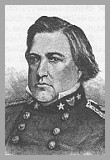 |
|
|
The whole fruits of General Nelson's victory at Ivy Mountain, and of his fatiguing and extraordinary march through a mountain country and over miserable roads, and in despite of high waters, will be lost by the removal of all of his troops; and, I fear, the Union cause in this section will be greatly injured. |
|
|
|
|
|
If the future looked bleak for the loyal citisens of Mount Sterling, it looked even bleaker for the men of the 5th Kentucky Infantry camped in the snow at Pound Gap. On November 13th, Colonel Williams wrote to General Humphrey Marshall at Wytheville, asking for "good rifles, clothes, great-coats, knapsacks, haversacks, and canteens." |
|
|
|
|
|
|
Brigadier General
Humphrey Marshall |
|
|
|
|
|
"Many of our men are barefooted," wrote Williams, "and I have seen the blood in their tracks as they marched from Ivy to this place." In early December, the editor of the Abingdon Virginian visited William's camp and recorded what he saw in his pocket notebook. A week later, he published the following melodramatic appeal: |
|
|
|
Ladies of Little Tennessee, we saw on Sunday last over one hundred barefoot, thinly-clad, but heroic Kentucky soldiers near Pound Gap, shivering with cold and marching to and fro over the frozen ground, with feet as red as those of pigeons, assisting to keep off from your hearths the Vandal scoundrels who have already invaded their own. Can you not spare them a few pairs of woolen socks, flannel shirts, and other necessities? |
|
|
|
 |
|
|
|
Back to Archive Main Page |
|
|
Go to Wheelwright Exhibit |
|
|
|
|
|
|
Go to Oldest House in the Valley |
|
|
Go to Seed-Planting Exhibit |
|
|
|
|
|
|
Go to Battle of Middle Creek |
|
|
Go to Steamboats Gallery |
|
|
|
|
|
|
 |
|
|
|
The maps on this page come to us courtesy of the Kentucky Historical Society in Frankfort, Kentucky. Photos of John C. Breckinridge, William Preston, and John S. Williams come to us courtesy of the Special Collections Department of the Margaret I. King Library of the University of Kentucky in Lexington, Kentucky. |
|




